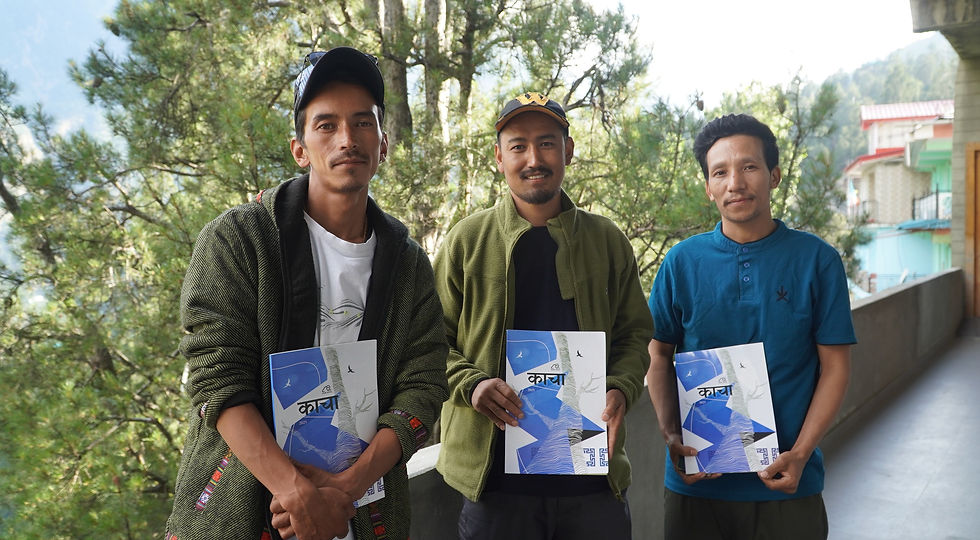Kacha 2.0 from the heart of Kinnaur
- Pramiti Negi
- Sep 11
- 4 min read
Written By Pramiti Negi
‘Kacha’ is a word of Tibetan origin. In several Tibetic and Western Himalayish languages
spoken across Kinnaur, it means a message. And today, Kinnaur has an exciting message
for the world.

Introducing Kacha, born 2024, a collective spark from Zed Tells, anchored in Kinnaur’s
grassroots and everyday truths. The second issue of Kacha this year brings together voices
and stories from across the Western Himalayas, resonating far beyond the region.
Much like its name, the magazine emerges from collective imaginations and shared
inheritance. It is a message spoken in the everyday voices of the mountains, shaped by the
wisdom of many generations and passed amongst storytellers.
It is easy to romanticise a place like Kinnaur. It is easier to ignore it. At Zed Tells, a youth-led
platform archiving the region’s indigenous knowledge, we always had a conscious
commitment to ensuring that our work opens space for more participatory, community-led
initiatives. Sitting with community elders, hearing fragments of memories and stories edged
with both pride and the ache of loss, deepened our commitment.
The first edition of Kacha took form as a refuge for urgent reflections, a space for half-formed
scribbles, and deep concerns that bubbled up among us. We wrote, our peers wrote, and
voices from our community added their threads. Each contribution was a testament to the
land being much more than a picturesque destination for Insta-perfect photos, more than a
borderland to be “administered accordingly”, or a trove of resources to be claimed.
The response we got from people upon publication caught us by surprise. Messages flooded
in from social media DMs, phone calls, and face-to-face conversations, people asking for
copies, eager to engage. Their warmth and enthusiasm unveiled something we had not fully
recognised before: the profound need for a rooted platform highlighting the voices of the
region.

For the second issue, we invited submissions from across the western Himalayas, while
keeping Kinnaur at the heart of our focus. After all the challenges we face across the rural
Himalayas, the ways we connect often mirror each other. Through the invisible bridges built
by social media, stories arrived from small villages in Uttarakhand, from the quiet valleys of
Lahaul, and the green folds of Kangra.
Like the people of the mountains, Kacha does not speak in the polished tones of power or
perfection. It stutters, sings, and sometimes interrupts itself.
Take, for example, a poet writing a song on the festival of Ukhyang. The composition is in
Hamskad, a language from Kinnaur without a script. So he uses Devanagari to give the
words shape. Then, translating it into Hindi for understanding by all.
This is the heartbeat of Kacha. It celebrates the resistance to being confined or boxed. I
remember a conversation with the team about a piece weaving effortlessly between Hindi,
English, and Kinnauri. Far from finding multilingualism challenging, presenting these languages together as intended by the author felt so natural. The authentic, raw voices in
these stories bring a unique charm that keeps you hooked from start to finish.
Our pages feature contributions from a wide range of voices, from college students finding
their footing to seasoned authors, including those from overseas who have connected to
these mountains for decades. A storyteller in her sixties pens her very first article.
Collaborating with each has been a joy; nurturing their unique voices and honouring their
varied styles has been a difficult but worthwhile journey.
Kacha also spills across forms. It is part poem, part documentation, part field note, part
grandmother’s tale. What unites it all is not uniformity but intimacy. Stories that arise directly
from on-ground efforts, like the dilemma of a scientist encountering a threatened native plant
species needing policy intervention, academic research made accessible so everyone can
engage.
Kacha’s deep-rooted integration with real-world action has also been significant to us. The
most compelling example is the snow leopard conservation initiative in Hango village. What
started as open conversations within the community soon grew into youth-led expeditions
and film screenings, drawing the whole village into a shared dialogue. These gatherings
nurtured a critical discourse around these magnificent but livestock-threatening predators.
Kacha’s role is part of this discourse. By weaving together the voices, anxieties, and
aspirations of this border village in Kinnaur, the magazine itself is part of the conservation
strategy. We now plan to distribute the magazines to the villagers. Shout out to our patrons
who have generously supported the distribution of Kacha to places like Hango, along with
school libraries and youth clubs across Kinnaur.
Kacha’s launch festival on 27th July at Reckong Peo was also part of our endeavour towards
creating meaningful space for discussion and nurturing it with care over time. It was a
people's festival in every sense: we sang songs, learned plant names in local languages,
had poetry reading sessions, and screened films made by the local youth. The walls hosted
a community photo exhibition entitled ‘Colours of Water’ where conversations flowed from
images into reflections on bumper-to-bumper hydropower construction in the Himalayas, the
toll of natural and man-made disasters, and the sacred beliefs tied to mountain water
systems.
In a time when the world seeks scalable solutions, viral content and formulaic writings,
Kacha moves dissimilarly. It is not merely a publication but a way of holding conversation, of
holding grief, of holding ground. We have a lot to learn, but the support of the communities
with whom we work has been heartwarming.
As Kacha gets ready for wider distribution, we warmly invite you to join us on this journey.
Order your copy with us and get prepared to be delighted by the stories and perspectives
each piece reveals.

Order via WhatsApp at +91 78275 62609 or through the Order Form.




Comments